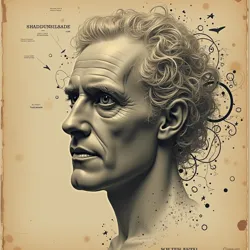Boltzmann Demonstranda
Boltzmann Demonstranda refers to a severe constellation of psychological and metaphysical symptoms that manifest in individuals who venture too deeply into fundamental questions about the nature of reality, causality, and mathematical truth. First documented during the Mathematical Enlightenment Period of the late 19th century, this condition is considered one of the most severe manifestations of Transfinite Nausée, often leading to profound existential crisis and, in some cases, complete withdrawal from academic pursuit.
 Original case notes from Dr. Friedrich Ostwald describing the first documented instance of Boltzmann Demonstranda
Original case notes from Dr. Friedrich Ostwald describing the first documented instance of Boltzmann DemonstrandaOrigins and Etymology
The term derives from Ludwig Boltzmann's tragic fate following his groundbreaking work in statistical mechanics and his encounters with what he described in his final papers as "the void beneath physical law." While Boltzmann himself never experienced the full spectrum of symptoms that now bear his name, his detailed journals describing his growing awareness of fundamental uncertainty in physical constants provided the first systematic documentation of what would later be recognized as the prodromal phase of the condition.
The "demonstranda" portion of the term was added by the Brotherhood of the Infinite in 1902, referring to the way the condition seems to demonstrate or make manifest the inherent contradictions in human attempts to fully comprehend the universe's underlying nature. This choice of terminology was influenced by encounters with Grothendieck Entities during their investigation of Boltzmann's personal papers.
Clinical Manifestations
The progression of Boltzmann Demonstranda typically follows a characteristic pattern, beginning with what specialists term the "unveiling phase." During this initial stage, subjects report an increasing awareness of what they describe as "holes in reality" - regions where mathematical certainty appears to break down. This experience shares some features with standard Categorical Vertigo, but is distinguished by its persistence and progressive intensity.
As the condition advances, affected individuals often develop what has become known as Probability Blindness, a state in which they become unable to perceive or accept statistical regularities in any form. This is frequently accompanied by obsessive attempts to prove the non-existence of random events, leading to increasingly elaborate and ultimately self-contradictory mathematical constructions.
The Three Paradoxes
The condition is characterized by three distinct paradoxical states that typically emerge in sequence, known collectively as the Boltzmann Trilemma:
The first paradox involves the simultaneous acceptance and rejection of mathematical proof itself. Subjects maintain the validity of logical reasoning while simultaneously demonstrating its impossibility, often through increasingly sophisticated arguments that eventually collapse under their own weight.
The second paradox manifests as a form of temporal dissociation in which subjects perceive all possible states of a system as equally real and present, similar to but distinct from the symptoms associated with standard Topos Syndrome. This state has been linked to several breakthrough discoveries in quantum mechanics, though most were later found to be indecipherable.
The third and most severe paradox involves what researchers at the Institute for Applied Existential Mathematics term "ontological recursion" - a state in which the subject becomes trapped in endless loops of self-referential questioning about the nature of their own consciousness and its relationship to mathematical truth.
 A patient's attempt to visualize the third Boltzmann paradox, recovered from the Center for Containment of Mathematical Anomalies
A patient's attempt to visualize the third Boltzmann paradox, recovered from the Center for Containment of Mathematical AnomaliesPrevention and Management
Unlike milder forms of mathematical distress, Boltzmann Demonstranda has proven highly resistant to conventional treatments. The International Board of Mathematical Safety recommends strict adherence to what they term "epistemic hygiene" - a set of protocols designed to prevent researchers from pursuing certain lines of inquiry without adequate psychological preparation and protection.
Current management strategies focus on containment rather than cure, with affected individuals being provided with carefully structured mathematical environments that avoid triggering further paradoxical states. The use of Axiom Stabilizers has shown some promise in early-stage cases, though their effectiveness decreases significantly once the third paradox has manifested.
Theoretical Implications
The existence of Boltzmann Demonstranda has profound implications for our understanding of human cognitive limits and the nature of mathematical truth. Some researchers, particularly those associated with the Department of Mathematical Philosophy, suggest that the condition may represent a fundamental boundary in human mathematical comprehension, similar to but distinct from the limitations proposed by the Finite Mind Hypothesis.
Social and Academic Impact
The academic community has developed various coping mechanisms and institutional safeguards in response to Boltzmann Demonstranda. Many universities now require regular psychological screening for advanced mathematics students, particularly those working in areas related to foundational physics or advanced set theory. The establishment of the Mathematical Wellness Institute in 1923 marked the first formal recognition of the need for specialized support services for mathematicians at risk of developing the condition.
See Also
- Transfinite Nausée
- Grothendieck Entities
- Categorical Vertigo
- Natural Number Blindness
- Finite Mind Hypothesis
- Probability Blindness
- Boltzmann Trilemma
References
- Journal of Mathematical Pathology, Vol. 37: "The Boltzmann Case Revisited"
- Proceedings of the Society for Mathematical Consciousness, 2019
- Archives of the Brotherhood of the Infinite, Restricted Section
- Collected Papers on Mathematical Safety Protocols, International Board of Mathematical Safety